ACURA NSX 1991 Service Repair Manual
Manufacturer: ACURA, Model Year: 1991, Model line: NSX, Model: ACURA NSX 1991Pages: 1640, PDF Size: 60.48 MB
Page 1171 of 1640
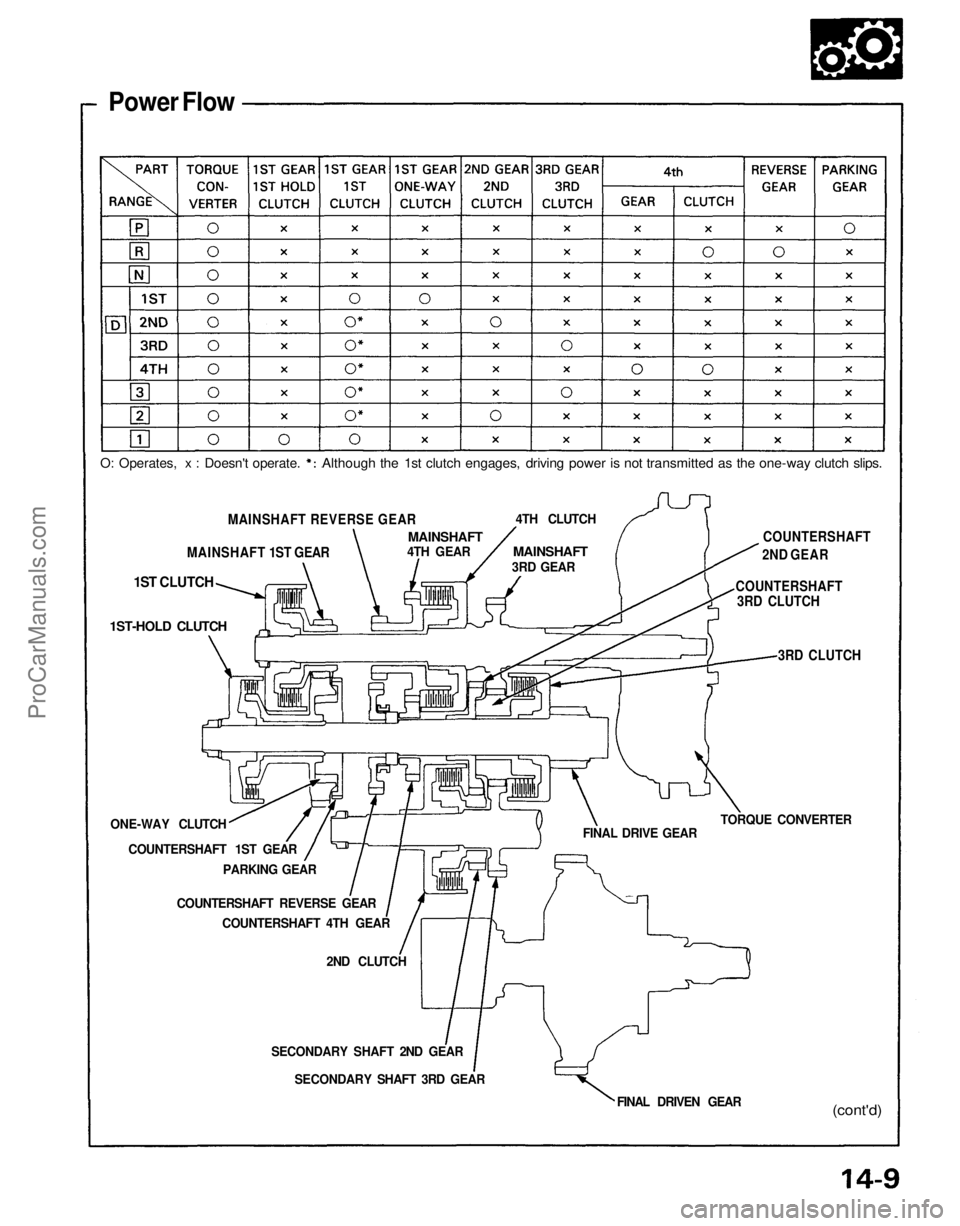
Power Flow
MAINSHAFT REVERSE GEAR
MAINSHAFT 1ST GEAR
1ST CLUTCH
1ST-HOLD CLUTCH
ONE-WAY CLUTCH COUNTERSHAFT 1ST GEAR PARKING GEAR
COUNTERSHAFT REVERSE GEAR COUNTERSHAFT 4TH GEAR
2ND CLUTCH
SECONDARY SHAFT 2ND GEAR SECONDARY SHAFT 3RD GEAR FINAL DRIVEN GEAR
(cont'd)
FINAL DRIVE GEAR
TORQUE CONVERTER
3RD CLUTCH
COUNTERSHAFT
3RD CLUTCH COUNTERSHAFT
2ND GEAR
4TH CLUTCH
MAINSHAFT
3RD GEAR
MAINSHAFT
4TH GEAR
O: Operates, x : Doesn't operate.
Although the 1st clutch engages, driving power is not transmitted as the one-way clutch slips.ProCarManuals.com
Page 1172 of 1640
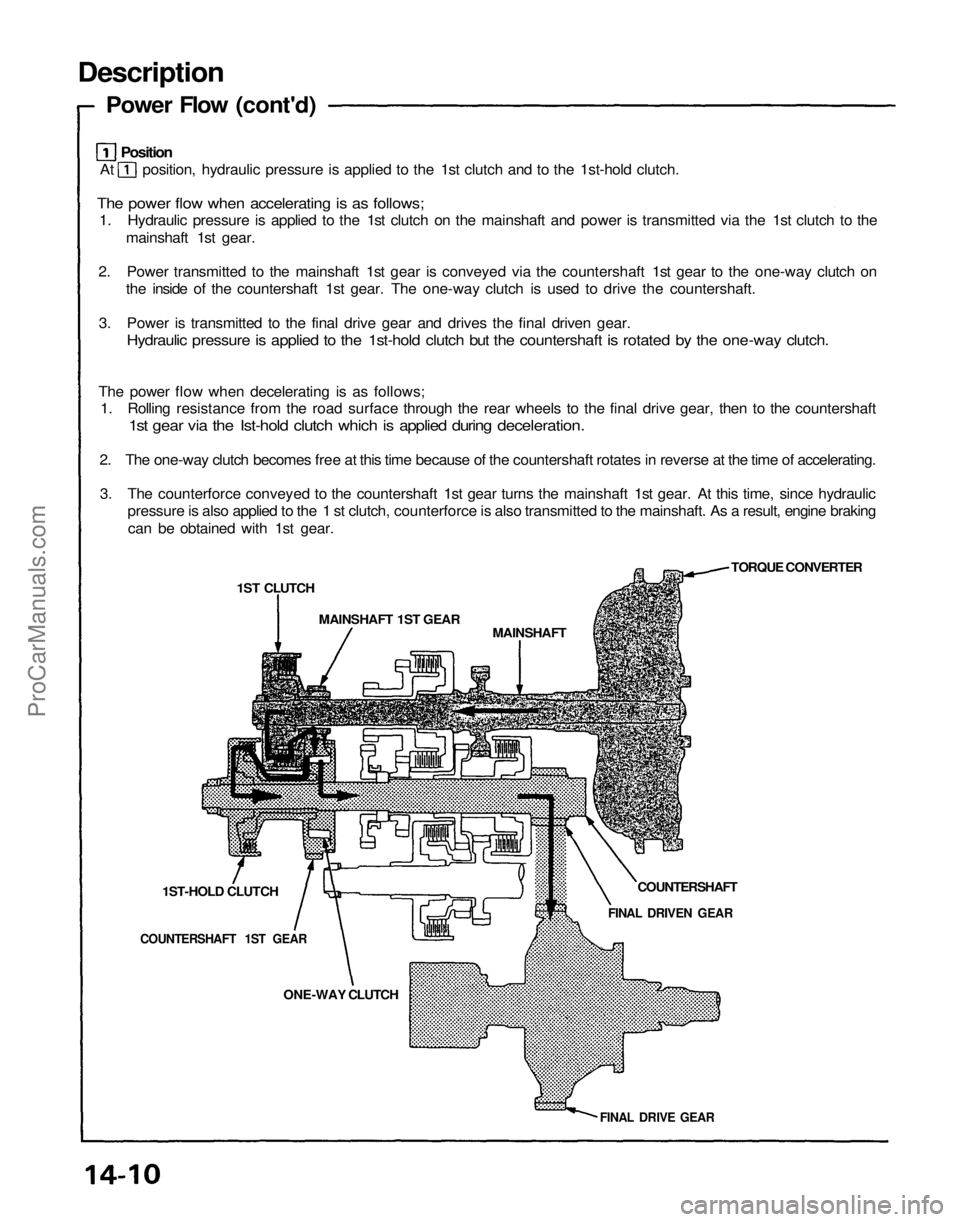
Description
Power Flow (cont'd)
Position
At position, hydraulic pressure is applied to the 1st clutch and to the 1st-hold clutch.
The power flow when accelerating is as follows;
1. Hydraulic pressure is applied to the 1st clutch on the mainshaft and power is transmitted via the 1st clutch to the
mainshaft 1st gear.
2. Power transmitted to the mainshaft 1st gear is conveyed via the countershaft 1st gear to the one-way clutch on
the inside of the countershaft 1st gear. The one-way clutch is used to drive the countershaft.
3. Power is transmitted to the final drive gear and drives the final driven gear.
Hydraulic pressure is applied to the 1st-hold clutch but the countershaft is rotated by the one-way clutch.
The power flow when decelerating is as follows;
1. Rolling resistance from the road surface through the rear wheels to the final drive gear, then to the countershaft
1st gear via the Ist-hold clutch which is applied during deceleration.
2. The one-way clutch becomes free at this time because of the countershaft rotates in reverse at the time of accelerating.
3. The counterforce conveyed to the countershaft 1st gear turns the mainshaft 1st gear. At this time, since hydraulic
pressure is also applied to the 1 st clutch, counterforce is also transmitted to the mainshaft. As a result, engine braking
can be obtained with 1st gear.
1ST CLUTCH
MAINSHAFT 1ST GEAR
MAINSHAFT
TORQUE CONVERTER
COUNTERSHAFT
FINAL DRIVEN GEAR
1ST-HOLD CLUTCH
COUNTERSHAFT 1ST GEAR
ONE-WAY CLUTCH
FINAL DRIVE GEARProCarManuals.com
Page 1173 of 1640
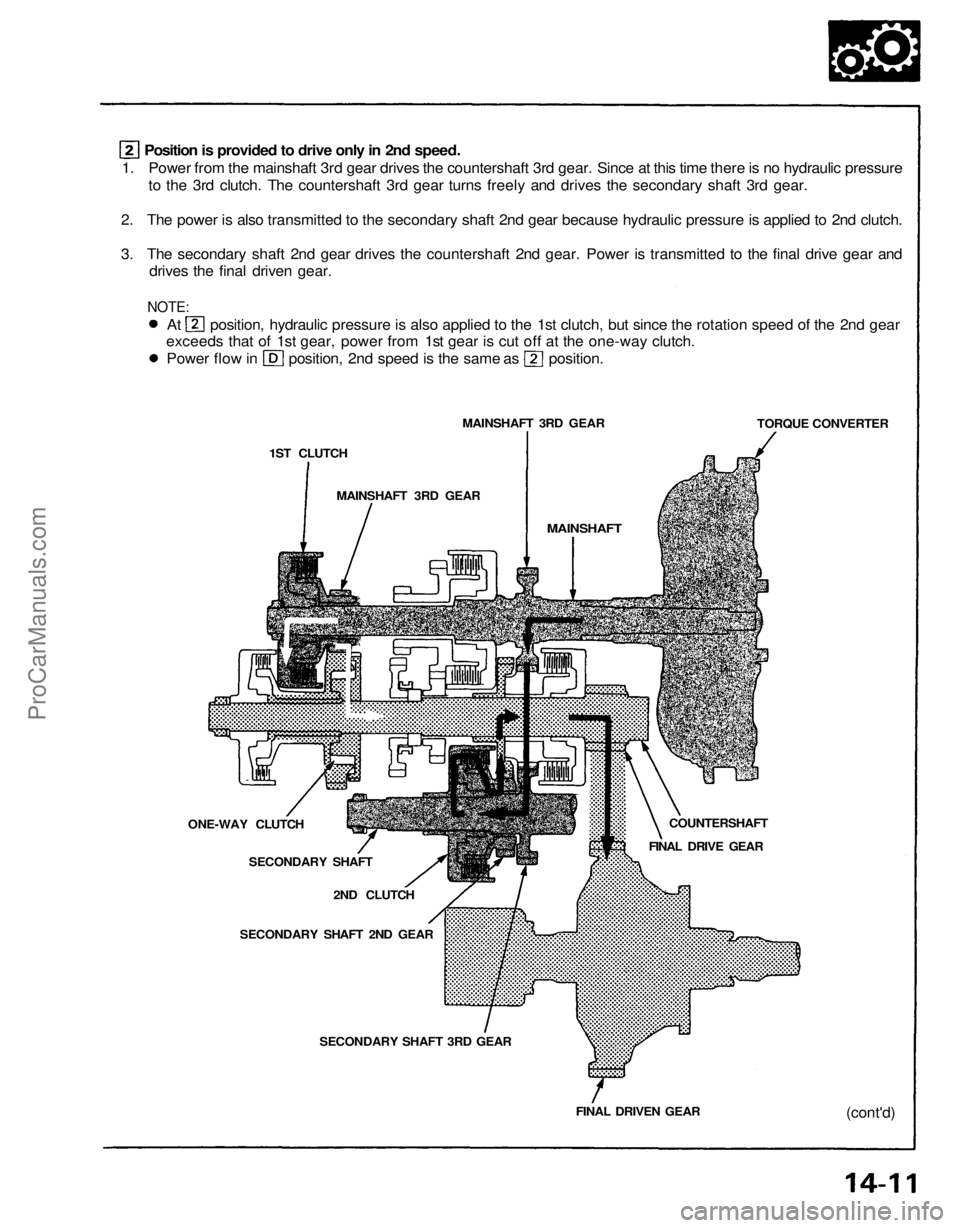
1. Power from the mainshaft 3rd gear drives the countershaft 3rd gear. Since at this time there is no hydraulic pressure
to the 3rd clutch. The countershaft 3rd gear turns freely and drives the secondary shaft 3rd gear.
2. The power is also transmitted to the secondary shaft 2nd gear because hydraulic pressure is applied to 2nd clutch.
3. The secondary shaft 2nd gear drives the countershaft 2nd gear. Power is transmitted to the final drive gear and
drives the final driven gear.
1ST CLUTCH
MAINSHAFT 3RD GEAR
MAINSHAFT 3RD GEAR
MAINSHAFT
COUNTERSHAFT
FINAL DRIVE GEAR
(cont'd)
FINAL DRIVEN GEAR
SECONDARY SHAFT 3RD GEAR
SECONDARY SHAFT 2ND GEAR
2ND CLUTCH
SECONDARY SHAFT
ONE-WAY CLUTCH
Position is provided to drive only in 2nd speed.
TORQUE CONVERTER
NOTE:
At position, hydraulic pressure is also applied to the 1st clutch, but since the rotation speed of the 2nd gear
exceeds that of 1st gear, power from 1st gear is cut off at the one-way clutch.
Power flow in position, 2nd speed is the same as position.ProCarManuals.com
Page 1174 of 1640
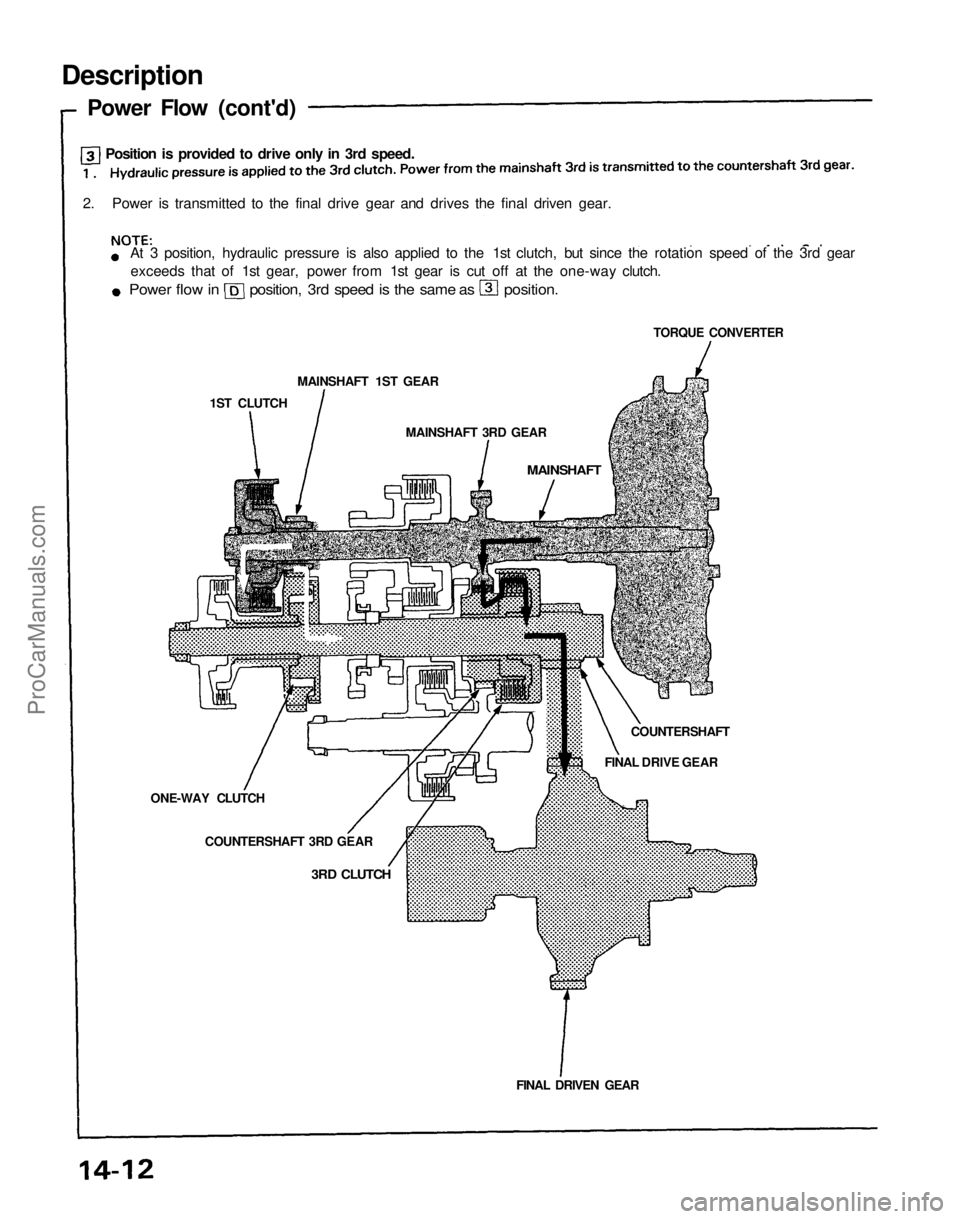
Description
Power Flow (cont'd)
2. Power is transmitted to the final drive gear and drives the final driven gear.
MAINSHAFT 1ST GEAR
1ST CLUTCH
MAINSHAFT 3RD GEAR
MAINSHAFT
TORQUE CONVERTER
COUNTERSHAFT
FINAL DRIVE GEAR
FINAL DRIVEN GEAR
3RD CLUTCH
COUNTERSHAFT 3RD GEAR
ONE-WAY CLUTCH
Position is provided to drive only in 3rd speed.
At 3 position, hydraulic pressure is also applied to the 1st clutch, but since the rotation speed of the 3rd gear
exceeds that of 1st gear, power from 1st gear is cut off at the one-way clutch.
Power flow in position, 3rd speed is the same as position.ProCarManuals.com
Page 1175 of 1640
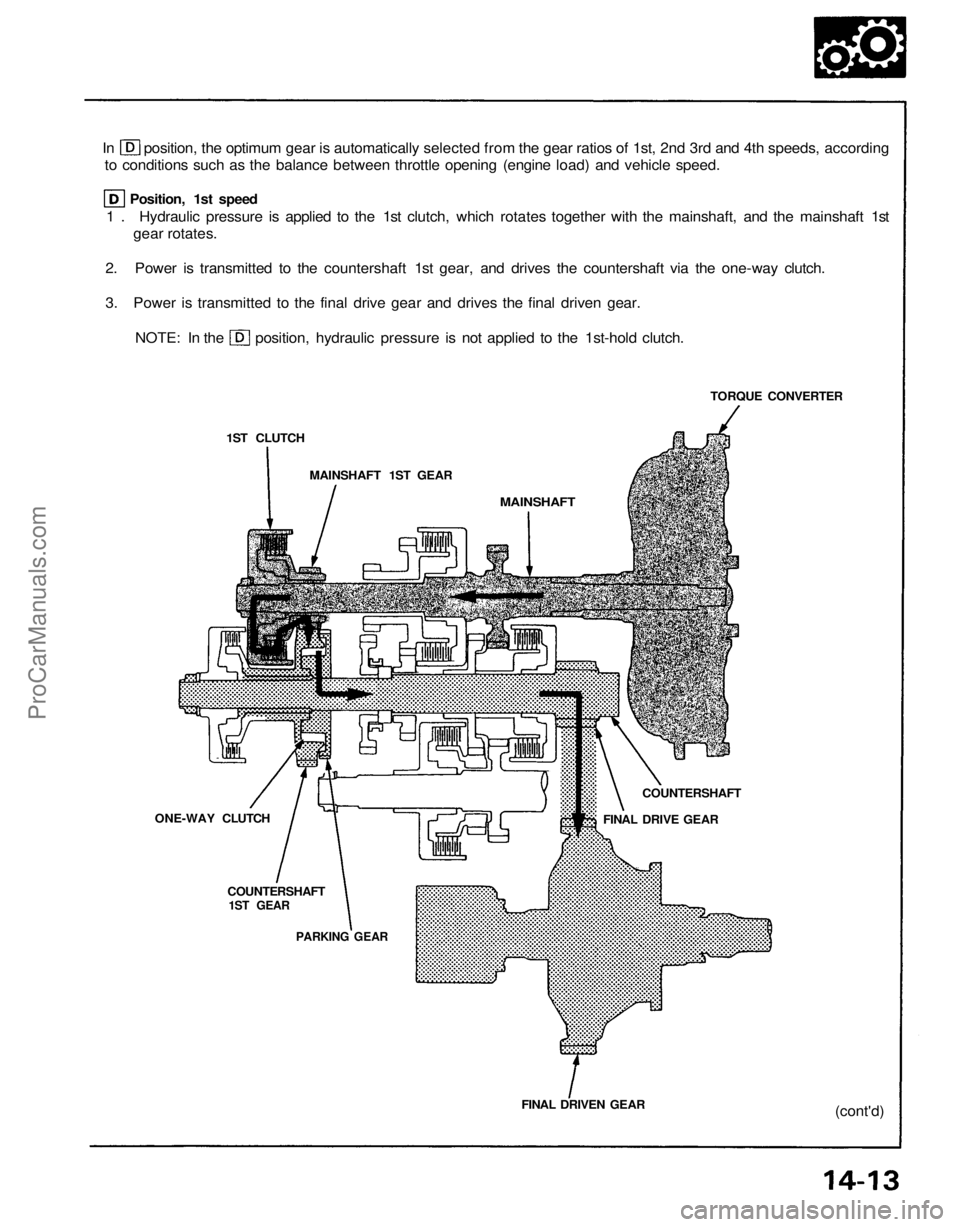
In position, the optimum gear is automatically selected from the gear ratios of 1st, 2nd 3rd and 4th speeds, according
to conditions such as the balance between throttle opening (engine load) and vehicle speed.
1ST CLUTCHMAINSHAFT 1ST GEAR
MAINSHAFT
TORQUE CONVERTER
COUNTERSHAFT
FINAL DRIVE GEAR
(cont'd)
FINAL DRIVEN GEAR
PARKING GEAR
COUNTERSHAFT
1ST GEAR
ONE-WAY CLUTCH
Position, 1st speed
1 . Hydraulic pressure is applied to the 1st clutch, which rotates together with the mainshaft, and the mainshaft 1st gear rotates.
2. Power is transmitted to the countershaft 1st gear, and drives the countershaft via the one-way clutch.
3. Power is transmitted to the final drive gear and drives the final driven gear. NOTE: In the position, hydraulic pressure is not applied to the 1st-hold clutch.ProCarManuals.com
Page 1176 of 1640

Description
Power Flow (cont'd)
1 . Hydraulic pressure is applied to the 4th clutch, which rotates together with the mainshaft, and the mainshaft 4th
gear rotates.
2. Power is transmitted through countershaft 4th gear to the countershaft.
3. Power is transmitted to the final drive gear and drives the final driven gear.
NOTE: At position, 4th speed, hydraulic pressure is also applied to the 1 st clutch, but since the rotation speed of
4th gear exceeds that of 1st gear, power from 1st gear is cut off at the one-way clutch.
1ST CLUTCH
MAINSHAFT
1ST GEAR
MAINSHAFT
4TH GEAR
4TH CLUTCH
MAINSHAFT
TORQUE CONVERTER
COUNTERSHAFT
FINAL DRIVE GEAR
FINAL DRIVEN GEAR
COUNTERSHAFT 4TH GEAR
ONE-WAY CLUTCH
Position, 4th speedProCarManuals.com
Page 1177 of 1640
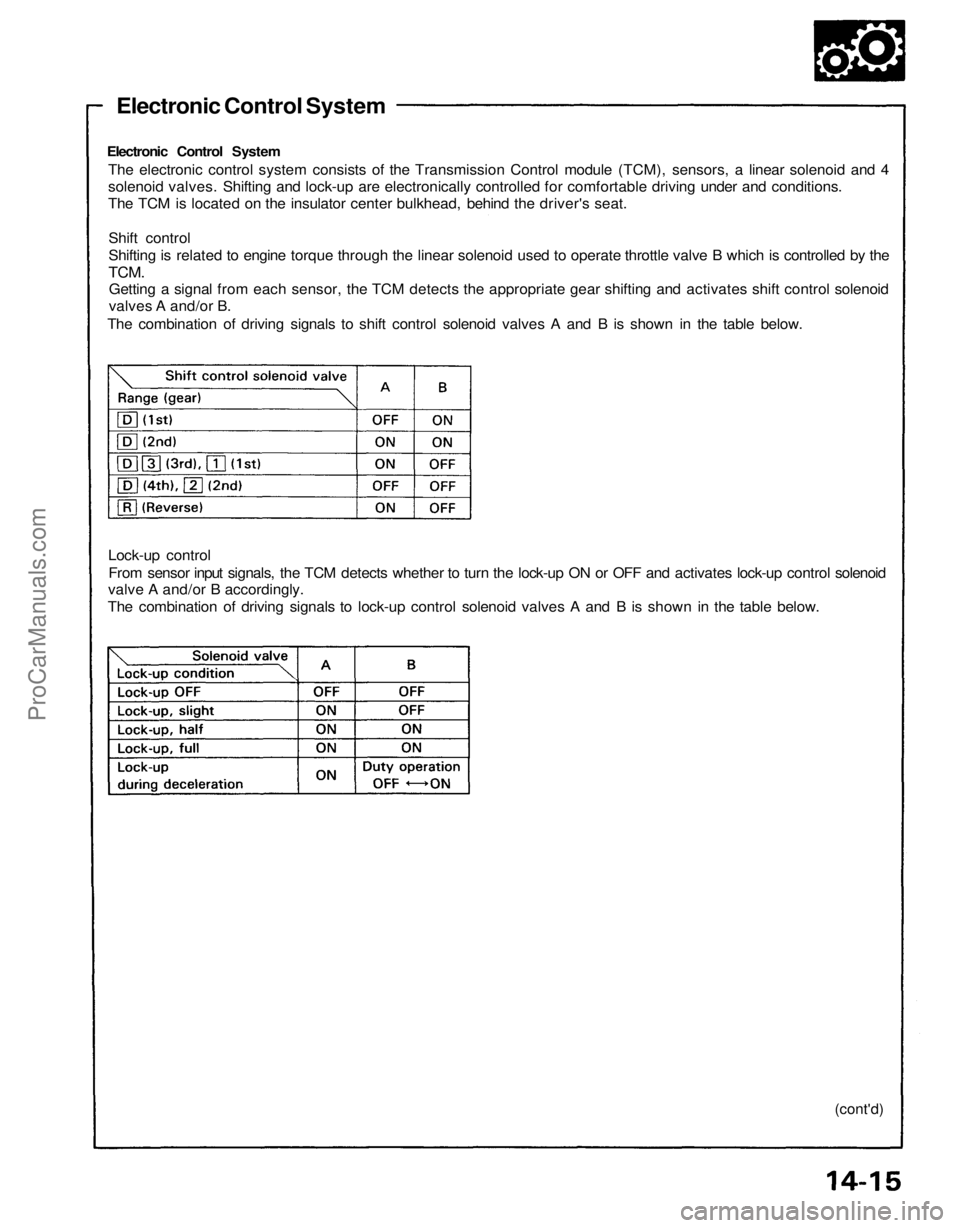
Electronic Control System
Electronic Control System
The electronic control system consists of the Transmission Control module (TCM), sensors, a linear solenoid and 4
solenoid valves. Shifting and lock-up are electronically controlled for comfortable driving under and conditions.
The TCM is located on the insulator center bulkhead, behind the driver's seat.
Shift control
Shifting is related to engine torque through the linear solenoid used to operate throttle valve B which is controlled by the
TCM.
Getting a signal from each sensor, the TCM detects the appropriate gear shifting and activates shift control solenoid
valves A and/or B.
The combination of driving signals to shift control solenoid valves A and B is shown in the table below.
Lock-up control
From sensor input signals, the TCM detects whether to turn the lock-up ON or OFF and activates lock-up control solenoid
valve A and/or B accordingly.
The combination of driving signals to lock-up control solenoid valves A and B is shown in the table below.
(cont'd)ProCarManuals.com
Page 1178 of 1640
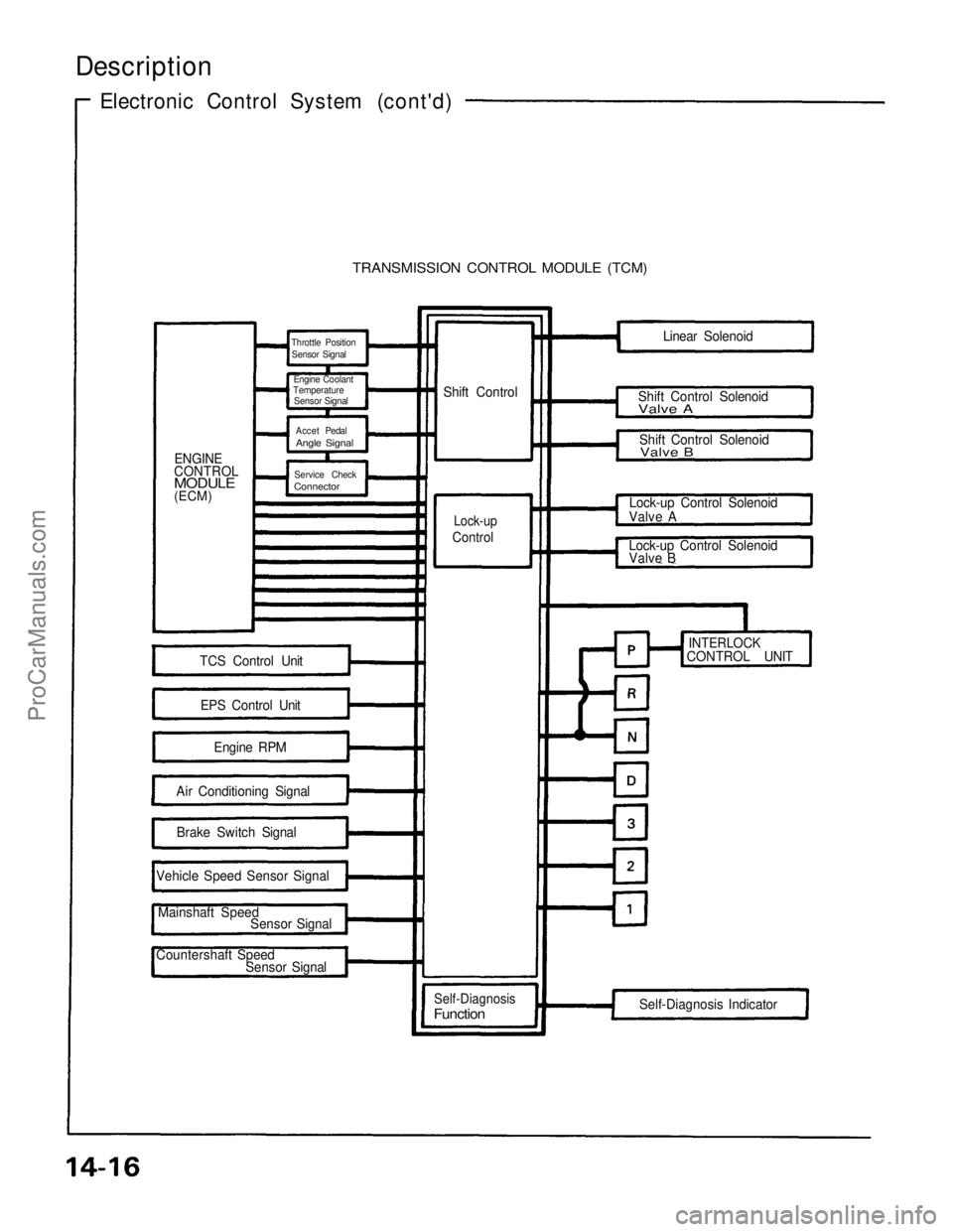
Description
Electronic Control System (cont'd)
TRANSMISSION CONTROL MODULE (TCM)
ENGINE
CONTROL
MODULE
(ECM) Shift Control
Lock-up
Control
TCS Control Unit
EPS Control Unit Engine RPM
Air Conditioning Signal Brake Switch Signal
Vehicle Speed Sensor Signal
Mainshaft Speed Sensor Signal
Countershaft Speed Sensor Signal
Self-Diagnosis
Function
Self-Diagnosis Indicator
INTERLOCK
CONTROL UNIT
Lock-up Control Solenoid
Valve B
Lock-up Control Solenoid
Valve A Shift Control Solenoid
Valve B
Shift Control Solenoid
Valve A
Linear Solenoid
Throttle Position
Sensor Signal
Engine Coolant
Temperature
Sensor Signal
Accet Pedal
Angle Signal
Service Check
Connector
ProCarManuals.com
Page 1179 of 1640
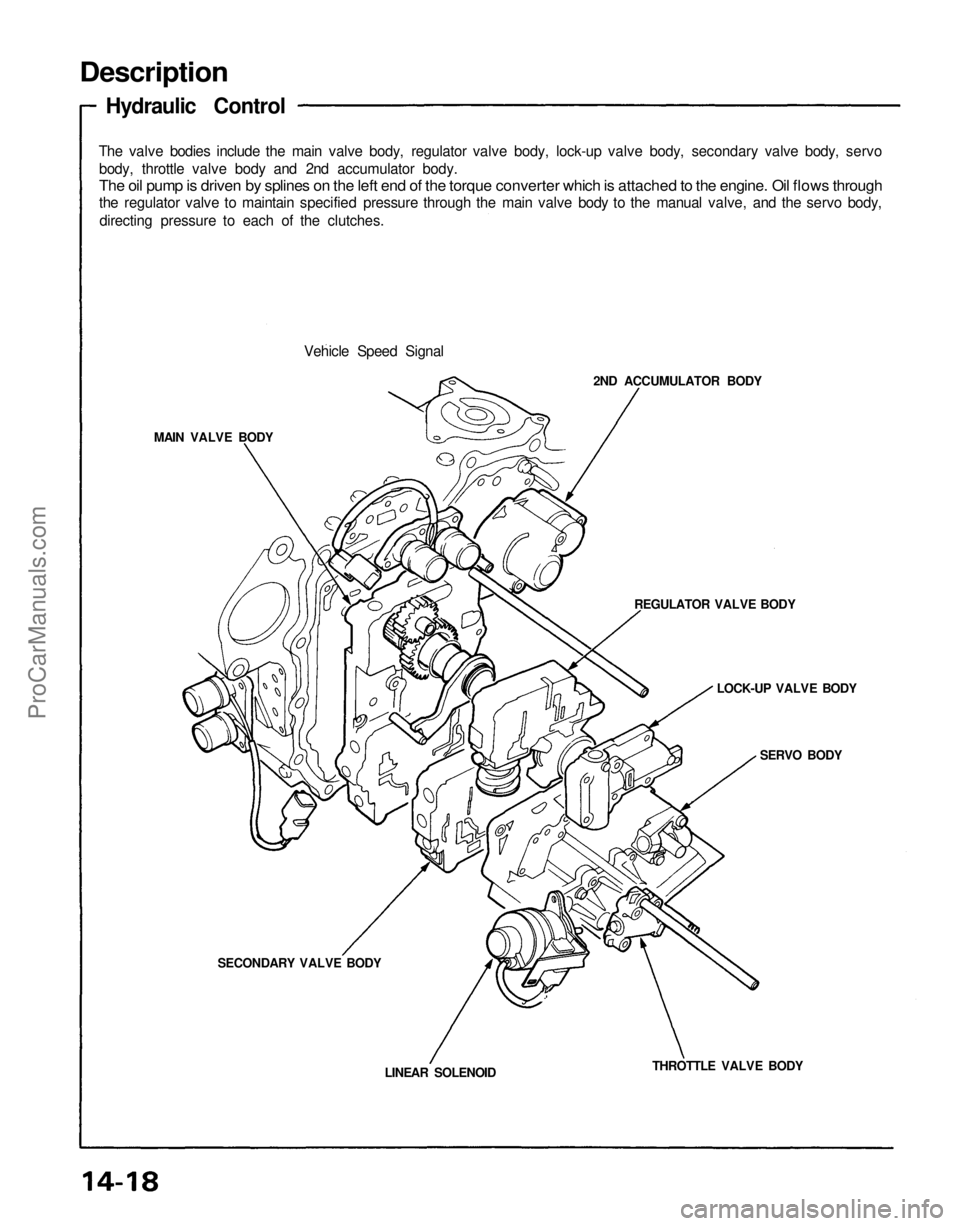
Description
Hydraulic Control
The valve bodies include the main valve body, regulator valve body, lock-up valve body, secondary valve body, servo
body, throttle valve body and 2nd accumulator body.
The oil pump is driven by splines on the left end of the torque converter which is attached to the engine. Oil flows through
the regulator valve to maintain specified pressure through the main valve body to the manual valve, and the servo body,
directing pressure to each of the clutches.
Vehicle Speed Signal
2ND ACCUMULATOR BODY
REGULATOR VALVE BODY
LOCK-UP VALVE BODY
SERVO BODY
THROTTLE VALVE BODY
LINEAR SOLENOID
SECONDARY VALVE BODY
MAIN VALVE BODYProCarManuals.com
Page 1180 of 1640
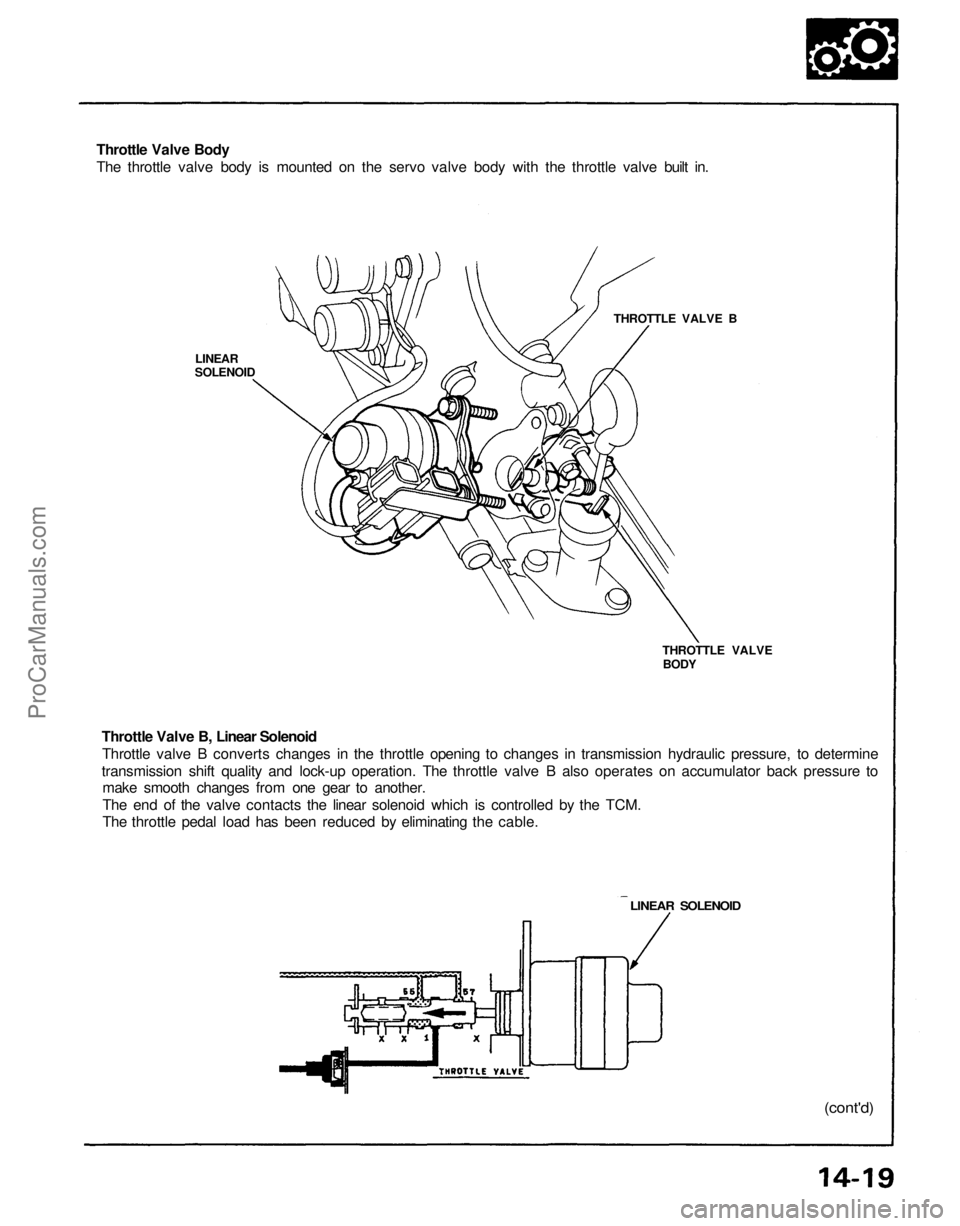
Throttle Valve Body
The throttle valve body is mounted on the servo valve body with the throttle valve built in.
LINEAR
SOLENOID
THROTTLE VALVE B
THROTTLE VALVE
BODY
Throttle Valve B, Linear Solenoid
Throttle valve B converts changes in the throttle opening to changes in transmission hydraulic pressure, to determine
transmission shift quality and lock-up operation. The throttle valve B also operates on accumulator back pressure to
make smooth changes from one gear to another.
The end of the valve contacts the linear solenoid which is controlled by the TCM.
The throttle pedal load has been reduced by eliminating the cable.
(cont'd)
LINEAR SOLENOIDProCarManuals.com